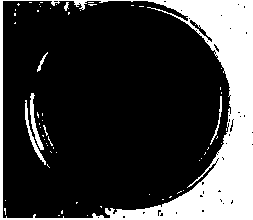Extraction process of environment-friendly blue pigment
An extraction process and an environment-friendly technology, applied in the direction of azo dyes, organic dyes, chemical instruments and methods, etc., can solve the problems of difficult effective separation of protein and pigment, large consumption of organic solvents, and easy adhesion to bottle walls, etc., to achieve extraction The process is environmentally friendly, improves the quality of the pigment, and is conducive to the effect of preservation
- Summary
- Abstract
- Description
- Claims
- Application Information
AI Technical Summary
Problems solved by technology
Method used
Image
Examples
Embodiment 1
[0048] Example 1 Acquisition of Streptomyces sp. YLA0 strain producing environment-friendly blue pigment
[0049] Take a 3-30cm soil sample from the peony rhizosphere cultivated in the peony area of Heze, Shandong Province. Take 5g of the soil sample and put it into a triangular flask (glass beads) filled with 45mL of sterile water. solution, diluted 10 times, took 0.1mL and spread it evenly on the modified Gaoshi No. 1 synthetic agar medium plate with a sterile glass coating rod, and placed it upside down in a 28°C incubator for 5-7d. Colonies producing blue water-soluble pigments were separated and purified by streaking three times in a row ( figure 1 and figure 2 ), the starting strain producing blue pigment, namely, Streptomyces sp. YLA11 strain can be obtained.
[0050] Inoculate the starting strain into the seed medium, collect and suspend the conidia of the starting strain with physiological saline, and make the spore concentration 1×10 8 - 10 9 cfu / ml spore suspen...
Embodiment 2
[0054] Example 2 Fermentation of Streptomyces sp. YLA0 strain producing environmentally friendly blue pigment to produce blue pigment
[0055] The method for producing blue pigment by adopting the Streptomyces sp. YLA0 strain producing environment-friendly blue pigment, placing the strain in a fermentation medium, and fermenting at 35-37°C for 2-9 days to obtain a fermentation broth The fermentation medium is made up of corn 20.0g, potassium nitrate 1.0g, sodium acetate 0.5g, dipotassium hydrogen phosphate 0.5g, magnesium sulfate 0.5g, manganese sulfate 0.01g, ferrous sulfate 0.01g and water 1000mL. The pH of the fermentation medium is 7.2-7.4;
[0056] Manganese sulfate is added to the fermentation medium to stimulate the production of more blue pigment.
Embodiment 3
[0057] Example 3 Analysis of biological characteristics of Streptomyces sp. YLA0 strain producing environmentally friendly blue pigment
[0058] Gao's No. 1 medium: 20.0 g soluble starch, 0.5 g casein, potassium nitrate (KNO 3 ) 1.0g, sodium chloride (NaCl) 0.5 g, dipotassium hydrogen phosphate (K 2 HPO 4 ) 0.5g, magnesium sulfate (MgSO 4 .7H 2 O) 0.5g, zinc sulfate (ZnSO 4 ) 0.01g, ferrous sulfate (FeSO 4 .7H 2 O) 0.01g, distilled water 1000ml, pH7.2-7.4.
[0059] 1. Morphological characteristics
[0060] On Gao's No. 1 medium, fluffy colonies can be formed when streaked and separated, and sparse light white fluffy colonies can be seen under the microscope in the early stage. Such as image 3 and Figure 4 The 48h colonies shown. Then gradually become thicker, white, but no blue pigment appears. Figure 5 (cultured for 60h), Figure 6 (cultured for 72h), Figure 7 (Cultivate for 96 hours), after 96 hours of cultivation, you can see the beginning of blue formatio...
PUM
 Login to View More
Login to View More Abstract
Description
Claims
Application Information
 Login to View More
Login to View More - R&D Engineer
- R&D Manager
- IP Professional
- Industry Leading Data Capabilities
- Powerful AI technology
- Patent DNA Extraction
Browse by: Latest US Patents, China's latest patents, Technical Efficacy Thesaurus, Application Domain, Technology Topic, Popular Technical Reports.
© 2024 PatSnap. All rights reserved.Legal|Privacy policy|Modern Slavery Act Transparency Statement|Sitemap|About US| Contact US: help@patsnap.com










